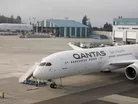Q&A: Talking super-long-haul flights and sustainability with Qantas

Australia’s national carrier Qantas has had a busy year. Not only has it received shipment of aircraft that will fly direct to London from Perth, it is also announced a commitment to flying with biofuels out of Los Angeles.
We asked the airline for details about these plans. Here is what its spokesperson had to say.
Outline Qantas’s ambitions for non-stop, super-long-haul flights from Australia to Europe and the US.
Over the years, Qantas has steadily reduced the number of stops and total journey time on flights from Australia to London and New York, and this has been made possible by advances in aircraft technology from manufacturers and optimisation of flight operations by Qantas.
It’s fair to say we’re on the brink of what we believe is going to be a golden era for travellers. We’ve put the challenge to both Airbus and Boeing to ensure their next-generation aircraft can make the distance to Europe and the USA non-stop.
Direct flights save a lot of travel time and hassle for our customers, because there’s no waiting around at an airport in the middle. When Qantas introduced the Kangaroo Route from Sydney to London in 1947, the journey took four days and included seven stops including two overnight stays. Flying non-stop will save almost four hours in travel time between Sydney and London, and likewise, travelling from Sydney to New York will save almost three hours for our customers.
By expanding the places we fly, and investing in all parts of the customer experience, we’re doing all we can to overcome the tyranny of distance and bring the world a little closer together.
What benefits will this bring to Australia and its economy?
Direct services to Europe and the US would be great news for Australian tourism and trade, bringing more tourists to the country and opening up opportunities for freight, particularly for our fresh produce and seafood.
It will also bring Australia closer to some of our biggest trade partners and sources of visitors in the world.
How close are aircraft manufacturers to producing the ideal aircraft to realise this ambition? How is Qantas helping to drive development/innovation?
No aircraft currently in service has the range to fly these direct routes with passengers and luggage at full capacity. Two next-generation aircraft that are currently in development – Boeing’s 777X and a long-range version of the Airbus A350 – can get close.
Airbus and Boeing want us to be a customer for their next-generation of aircraft because the routes we fly are often an excellent demonstration of the potential of their aircraft.
We’ve often worked with suppliers to make sure new aircraft have the range we need – going right back to the 707, the 747SP and the 747ER. We worked closely with Boeing in the 787 design, and will continue to work closely with both manufacturers on developing their next generation aircraft.
You recently took delivery of your first Boeing 787-9 which can fly direct from Perth to London. How significant a step is this for Qantas?
While taking delivery of a new aircraft is always an important milestone for an airline, the 787 is a game-changer. From the distance it’s able to fly to the cabin design, the Dreamliner marks the start of an exciting new era for Qantas and how Australians travel.
The Dreamliner makes routes like Perth to London possible, and when it takes off next March it will be the first direct service linking Australia to Europe – making other potential routes right across Europe and the US a possibility.
There are many elements that combine to make the Qantas Dreamliner special. From the new seating, entertainment and crockery – we’re also working with sleep specialists, dieticians and others at the University of Sydney to see how adjustments to our inflight service can help our customers adjust to new time zones and counter jetlag. It’s world-first research partnerships like these that have the potential to significantly alter the future of long-haul flying.
How important is sustainable flying to Qantas? Will you be looking to extend the use of biofuel-powered flights beyond those in and out of LA?
As an airline group, we’re constantly looking for ways to become more fuel efficient and embrace new technologies. Through our recently announced biofuel program, we’re demonstrating our commitment to lowering carbon emissions across our operations.
While our primary focus is on establishing an aviation biofuel industry in Australia, we’re also looking at opportunities overseas, particularly those destinations where the industry is more advanced.
Are there any other sustainable initiatives Qantas is working on that should be highlighted?
Qantas Future Planet is our flagship program for sustainability, environmental and social initiatives – covering areas as broad as aircraft and fuel efficiency like biofuel and carbon offsetting, to sustainable products and inflight programs.
We’re proud to have recently celebrated 10 years of carbon offsetting. Our corporate program is now the world’s largest airline offset program, and offsets corporate travel and ground fuel emissions to help counteract the unavoidable impact of air travel.
What are your general observations on the Australian aviation industry - is it in a healthy place and how do you envisage the next 5-10 years in terms of growth and prosperity?
In the year ending August 2017, Australia welcomed 8.7mn international visitors, up 8.2% from the previous year*.
This figure will undoubtedly increase as the world becomes even more connected through aviation, and for a national-carrier like Qantas it’s important we continue to recognise and adapt to these trends in real-time while thinking about sustainability over the long term.
*Tourism Australia - Tourism Statistics
- How do you plan for something you can’t predict?Leadership & Strategy
- Virgin Australia suspends all flights due to COVID-19Leadership & Strategy
- Qantas commits to carbon offsetting to reach net-zero emissions by 2050Leadership & Strategy
- World’s longest flight to go from New York to Sydney leaves todayLeadership & Strategy

